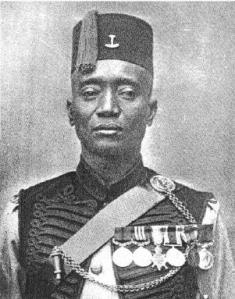History
The regiment was formed in 1879 as the Gold Coast Constabulary, from personnel of the Hausa Constabulary of Southern Nigeria, to perform internal security and police duties in the British colony of the Gold Coast. In this guise, the regiment earned its first battle honour as part of the Ashanti campaign. [1]
The Gold Coast Constabulary was renamed in 1901 as the Gold Coast Regiment, following the foundation of the West African Frontier Force, under the direction of the Colonial Office of the British Government. The regiment raised a total of five battalions for service during the First World War, all of which served during the East Africa campaign. During the Second World War, the regiment raised nine battalions, and saw action in Kenya's Northern Frontier District, Italian Somaliland, Abyssinia and Burma as part of the 82nd West African Division, the 24th Gold Coast Brigade, [2] and the 2nd (West Africa) Infantry Brigade. [1] The age of soldiers enlisted into the military could vary greatly between 7 and 50 years, whereas the majority (90 per cent) was between 18 and 30 years. [3]
In 1957, the Gold Coast became the first sub-Saharan nation to be granted independence from Great Britain. In 1959, the Gold Coast Military Forces, including the Gold Coast Regiment, were withdrawn from the Royal West African Frontier Force. With the country's change of name to Ghana, the regiment was renamed the Ghana Regiment. [1]
Today, the regiment forms the bulk of the Ghanaian Army, with a total of six battalions, divided equally between the army's two brigades. As the army's main force, it is responsible for Ghanaian internal security and defence. Ghana also makes a large commitment to peacekeeping operations in the region and overseas, most notably in Sierra Leone and Liberia, for which the Ghana Regiment provides the majority of personnel. [1] The Ghana Regiment follows the British Army closely in kit, traditions and training, and are generally well-regarded by their Western European and North American peers whilst on UN deployments and joint-operations.
This page is based on this
Wikipedia article Text is available under the
CC BY-SA 4.0 license; additional terms may apply.
Images, videos and audio are available under their respective licenses.
